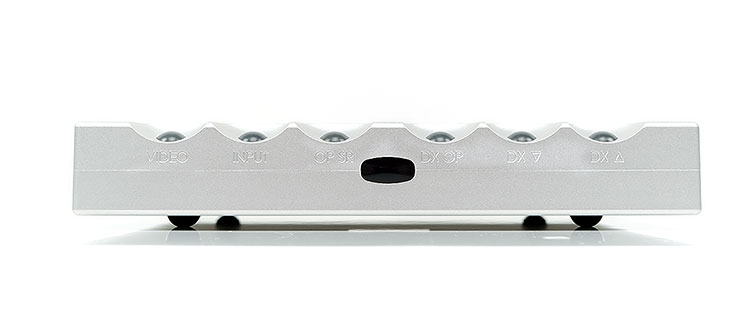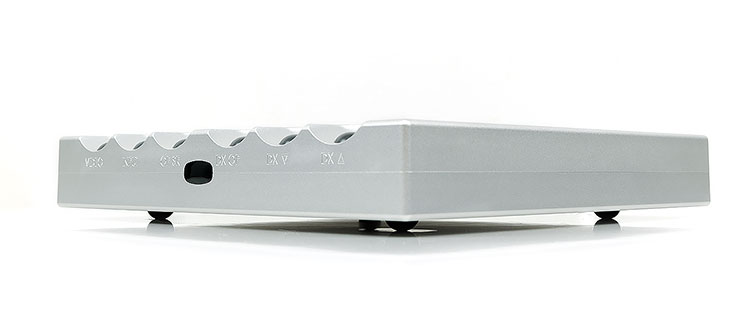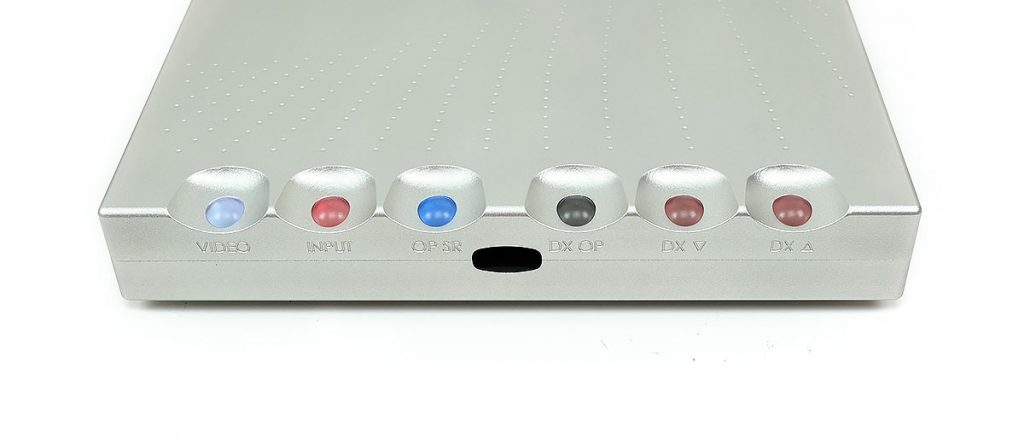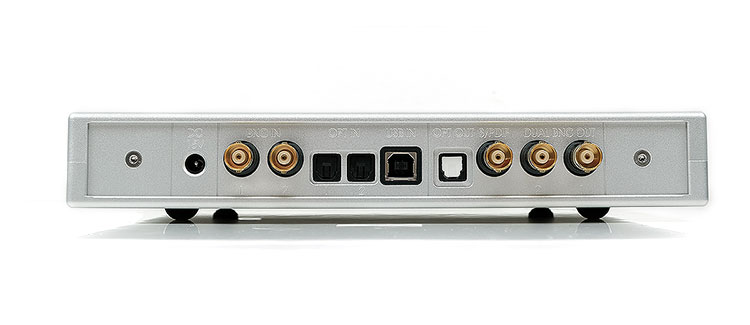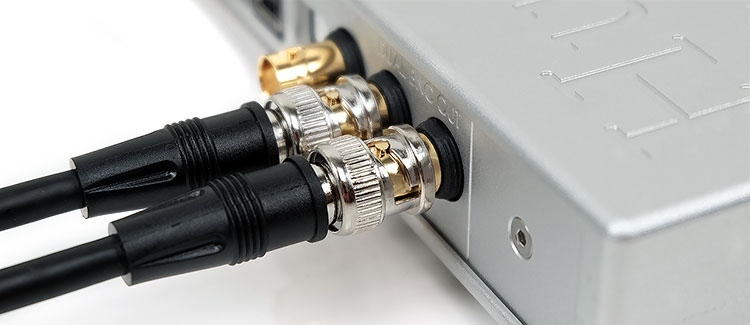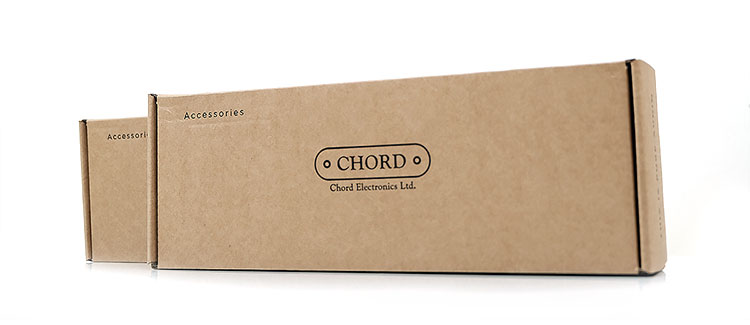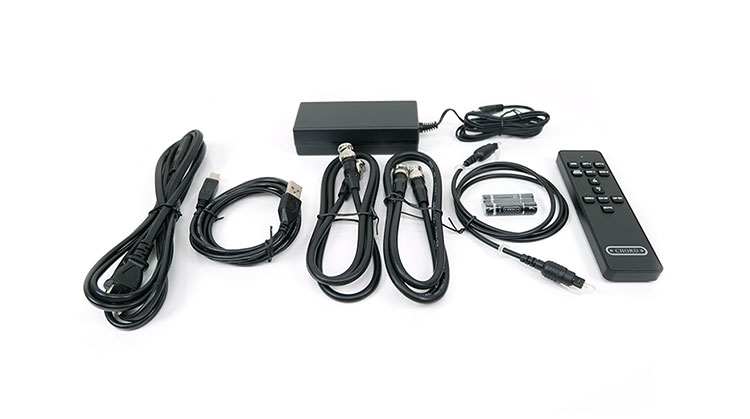The Chord Electronics Hugo M Scaler is a unique high-end upsampling component capable of upsampling digital streams from 44.1k up to 705.6kHZ (maximum of 768kHz). It is priced at £3495.
Disclaimer: This is a sample in exchange for our honest opinion. Headfonics is an independent website that does not have any affiliate links or status. We thank the team at Chord Electronics for giving us this opportunity.
You can read more about the Chord Electronics products we reviewed on Headfonics by clicking here.
Note, that this article follows our latest scoring guidelines which you can read here.
The gestation period for this M Scaler review has been long, perhaps almost too long. However, the upshot is a degree of familiarity with the capability of this device almost like no other before putting pen to paper.
That is a critical point because if you simply plug the M Scaler into a DAC, turn on your amp, and connect some headphones you may not necessarily get what the big deal is at first. That initial listen might not reveal what the magic is. That, combined with the top-tier pricing, might leave you feeling underwhelmed.
I had that initial issue during CanJam Singapore 2019 with a set of HE5SE from Hifiman plugged into a TT2 with the M Scaler right behind it. The HE5SE is not a reference headphone and its old-school technical capability leaves much to be desired in terms of imaging. Its timbral qualities are appealing, technical capability is less so.
Picking the right setup, the right headphones, and the tracks you know and understand are critical to overcoming that first hurdle.
The Hugo M Scaler is not a quick-fix timbral choice. It is not an EQ tool nor will it redefine the core FR of any headphone. The secret sauce of the M Scaler lies in the technical domain and in that domain, it can and is utterly brilliant.
Tech Inside
Upsampling
In short, The Hugo M Scaler is a standalone upscaling device that acts as the first port of call for any digital audio source or transport such as a laptop or CD Player. It then sends the resulting upsampled digital signal to the DAC of your choice for decoding into analog.
The upsampling technology first saw the light of day on their flagship BLU MKII digital/CD transport launch a year or two ago so it is not an entirely new line of technology from Chord. However, it is officially Rob Watt’s most advanced version at the time of writing and their first such standalone device to focus solely on upsampling.
Process
The M Scaler uses a complex Xilinx XC7A200T FPGA with 740 DSP cores to create WTA (Watts Transient Alignment) filtering capable of upsampling digital streams from 44.1k up to 705.6kHZ (maximum of 768kHz).
DACs such as the Hugo 2 and Qutest share the same initial stage of converting a digital signal as the M Scaler, (upsampling). Duplication? Not quite because by using the M Scaler to bypass the initial stage or WTA 1 this is seen as a considerable upgrade on their stock stage 1 DAC process.
That is quite important as virtually all DACs have some element of upsampling but perhaps not as complex as the M Scaler.
Therefore, regular DAC upsampling interpolation or resulting resolution may not be as accurate compared to the M Scaler output. That upscaled signal is then finally sent to the connected DAC which recognizes it in its new upsampled state rather than the original source rate.
Modular Benefits
By ‘outsourcing’ the process to a dedicated component, not only is Chord able to dedicate all the power required by the M Scaler’s internal FPGA but they, in turn, can build a modular system that is properly equipped to reduce any noise from those additional power demands.
The M Scaler is also not restricted to any single source such as a CD player. It can be attached to any compatible transport and DAC. It has the functionality to pair with any USB-capable output such as a laptop but ideally, it works best with a Chord Electronics DAC for a few reasons.
Chord DACs
Pairing with Chord DACs is not just sales speak in favor of Chord products. Whilst you can link the M Scaler to any DAC, the inclusion of dual BNC connectors means you can directly link 2 BNC cables to the likes of the DAVE, TT2, and the Qutest (which we have here), and all will recognize the M Scaler and respond accordingly.
A dual BNC connection will also give you the highest rate of sampling possible at PCM 768kHz (from 96kHz input). Other single BNC DACs will tap out at PCM 352.8 kHz.
Of course, you are not limited to BNC input and outputs with the M Scaler. You can also use an optical and coaxial output as well as 2 optical inputs giving you the potential to link up to 4-5 different sources to the M Scaler and upsample and output to 3 to 4 different DACs.
Design
The M Scaler is unmistakably a Chord Electronics product. There is a certain ethos, design flow if you will, for any Chord Electronics gear from the Mojo up to the DAVE and the M Scaler is no different.
Well, it has to be that way to fit neatly on top of a TToby or TT2 which is how the team has envisaged this all comes together. For those that are coming from a Hugo or Hugo 2, it is a bit like having a giant version of that design, the two are not that far off.
It is also extremely robust with a very high level of build quality. The silver-finished chassis, much like the Hugo 2 is carved from an aluminum block and consists of two parts adorned with 4 rubber feet on the base and held together with 4 discreet screws.
Front
The front houses the same color orb scheme as the Hugo 2, although on a more complex level.
From left to right there are options for Video filtering, input selection, and sample rate as well as 3 DX choices which only come alive when they receive a sample rate (DX OP) or, as Chord Electronics has alluded to when connected to future product lines that have yet to be revealed.
Input Selection
The Hugo M Scalers input selection on the left is color-coded with up to 7 color options. Two of these options are more of an auto-select and the rest a manual selection. Those two are coded pink for automatic and blue for automatic Dual BNS.
If you set the M Scaler to pink it will default to whatever source is currently connected and active without you having to worry about chopping and changing. Pink will be the default input selection for the majority of systems. The remaining manual sections are as follows:
- White – USB
- Orange – BNC 1 input
- Red – BNC 2 input
- Green – Optical 1
- Dark Blue – Optical 2
Sampling Rates
The switchable sample rate or OP SR is your key button on the M Scaler for audio playback. Here you can select from 4 core options and they are also color-coded:
- Red – low
- Green – medium
- Blue – high
- White – maximum
The designations are a little crude but it is more a high-level interpretation of what to expect. The actual sample rates you will get under each designation do vary with factors such as the input medium, (USB, BNC, or optical) and the output cable (BNC, dual-BNC, and optical).
For reference purposes, only Dual-BNC output will give you the top rate of 768kHz output. Optical output has a maximum upsampling capability of 176.4kHz which is logical considering you cannot go further than 24/192 on an optical interface. If you are using hi-res files already, (24/192), the benefit of using optical output upsampling is marginal to none.
If you elect to use a single BNC input or single BNC output to a 3rd party DAC then the maximum sampling rate is capped at 352.8kHz input and 384kHz output. Even if your input is USB and your output is a single BNC then the output rate is the same.
This is the benefit of going Dual-BNC with Chord’s DACs which can receive a Dual-BNC cable input.
Video Filtering
Just a note on the far-left video filtering feature which is slightly different from the core switchable sample option. You will not get quite the optimal tap length and sample rate output using video because of the latency inherent in the upsampling process.
The video feature thus lowers the sampling marginally to achieve a proper sync with audio and video from your source file. Having tried that using YouTube and some high-bit rate local storage video files I can confirm it does exactly that.
Lighting
One other function, and one that Chord Electronics product users often find necessary is the ability to dim those orb lights.
You can dim or enhance the orb light strength via the last two DX buttons. Generally speaking, I tend to take them all the way down so they do not distract me when watching a movie or streaming.
The Orb light sequence works in much the same manner as the Hugo or Qutest and with dual BNC I have found our Qutest to match the color sequences of the M Scaler, particularly for sample rates which are very assuring.
Rear
The rear panel is more of a traditional hi-fi design rather than the inset Hugo 2 style which I do like. Mind you it is not possible to inset BNC connections and there are 5 coaxial sockets for that, with 4 dedicated for BNC (input and output) and one for SPDIF (output).
The Hugo M Scaler does use a switching 15V/4A SMPS power supply but I am told the power demands are not that high for a desktop product.
In the middle, you have 3 optical ports, 2 for input and 1 for output, and a single USB socket for receiving a digital signal from the likes of your PC or other digital audio transport.
This is my first time working with BNC cables but I am impressed with their locking mechanism. Just a simple push, twist, and release and it grips tight. the cables also seem pretty sturdy though not terribly long so you do need your partnering DAC fairly close.
Connections
The Hugo M Scaler is designed to be the first-stop digital processor from whatever transport you are using before the source signal is decoded to analog by a DAC.
So long as you have an outgoing connection either via USB, coaxial, or optical then the setup is entirely up to you and the system you have. Just remember to keep your input selector on the automatic input pink color orb option so you can move quickly between multiple sources.
We would say, however, that a USB/dual-BNC input/output is likely to yield the most beneficial results given its ability to transmit at a higher rate than optical.
Setup
For the review, we opted for a Windows 10 Acer Nitro setup, Roon, and Foobar2000. File playback was in FLAC from 44.1K up to DSD512 as well as a selection of video streamed or on external storage.
From the Qutest we have our analog signal initially connected to the Auris HA-2SE and Xi Audio’s Formula S. However, we found that electrostatic amplification and electrostatic headphones to be the most impressive with the M Scaler.
Outside of electrostatic headphones, we focused on using the excellent Diana Phi or Hifiman’s Susvara which are two planar headphones I believe can best capture the way the M Scaler changes the presentation.
We do have one other highly capable upsampling device, the NuPrime CDP-09, which is primarily a DAC and CD Player but does have some switchable sample rates. You will find out direct comparison also on page 2 of the review.
Accessories & Packaging
Nothing fancy here really, it is more of a traditional Hi-Fi style unboxing experience with a plethora of brown cardboard and gridwork foam bars protecting both the unit and the accessory boxes for transportation. You will not find anything ‘Hollywood’ with the M Scaler unboxing experience.
Accessories
The accessory line-up for the M Scaler comes in two plain brown rectangular boxes and is packed with all the essentials to get the M Scaler up and running. More than that they include a couple of BNC coupler-terminated cables which means you can hook up your TT, Qutest, or DAVE right away for maximum performance.
The full accessory lineup is as follows:
- 1.5m 15v 4A Switching power supply
- IR Remote Control (with 2 non-rechargeable Chord Electronics branded batteries)
- Dual BNC Cables
- M Scaler User Manual
- USB Cable
- Optical cable
Hang onto that remote. In our testing to date, the remote has been excellent. A product like the M Scaler, whilst not exactly being tucked out of sight is rarely something I want to continually walk across the room or reach for to change sample rates or inputs during listening. The remote takes care of everything for that couch potato lifestyle that we audiophiles wholly embrace.
Click on Page 2 below for Performance Impressions & pairings



